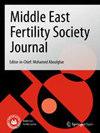Impact of treatment interventions of endometriomas prior to in vitro fertilization: a systematic review and meta-analysis
IF 1.3
Q4 REPRODUCTIVE BIOLOGY
引用次数: 0
Abstract
Treatment of endometrioma before in vitro fertilization (IVF) is challenging as it may affect ovarian response to induction. A systematic review to search for the available optimal management of ovarian endometrioma before ovulation induction in IVF. Screening of the MEDLINE, Web of Science, EMBASE, Cochrane database, and the clinical trial registration sites, covering the period from their inception up to June 2023 was done by two reviewers independently using the keywords ovarian endometrioma, ovarian endometriosis, endometrioma/surgery, endometrioma/hormonal treatment, randomized controlled trial(s), case-controlled studies, and cohort studies. All types of studies were included. Participants included were women with unilateral or bilateral ovarian endometriomas candidate for IVF/ICSI. We included 18 studies in the review. Three studies were randomized controlled parallel studies, six were prospective cohort, and nine were retrospective cohort studies. Data from all included studies were extracted by two authors (A. M., A. O.) independently. Data extracted included sample size, population characteristics including age, BMI, duration of infertility, ovarian reserve markers, cyst size, and bilaterality and induction protocol used. We found 18 studies. Women with untreated endometrioma had significantly higher numbers of MII oocytes (the mean difference (MD) effect estimate was − 0.53 with [− 1.04, − 0.01] 95% CI and 0.04 P-value), higher number of obtained embryos (MD effect estimate was − 0.25 with [− 0.38, − 0.11] 95%CI and < 0.001 P-value), and required lower doses of gonadotropins for induction (MD effect estimate was 361.14 with [168.13, 5554.15] 95% CI and < 0.001 P-value) compared to those who had undergone surgical management of endometrioma. However, live birth (OR effect estimate was 0.79 with [0.54, 1.18] 95% CI and 0.25 P-value), clinical pregnancy (OR effect estimate was 0.95 with [0.72, 1.26] 95% CI and 0.73 P-value), miscarriage (OR effect estimate was 0.74 with [0.33, 1.63] 95% CI and 0.45 P-value), cancellation rates (OR effect estimate was 1.62 with [0.57, 4.66] 95% CI and 0.37 P-value), and the duration of stimulation (MD effect estimate was 0.19 with [− 0.42, − 0.81] 95% CI and 0.54 P-value) did not show any significant difference between the two groups of women. Hormonal treatment of endometrioma was associated with higher ongoing pregnancy rate (OR effect estimate was 3.39 with [1.83, 6.26] 95% CI and < 0.001 P-value), higher clinical pregnancy rate (OR effect estimate was 3.36 with [2.01, 5.63] 95% CI and < 0.001 P-value), and higher numbers of MII oocytes (MD effect estimate was 2.04 with [0.72, 3.36] 95% CI and 0.003 P-value) when compared to women who did not receive such therapy. These effects were evident in treatment with GnRH agonists, OCPs (oral contraceptive pills), and dienogest, while the miscarriage and cycle cancellation rates did not show these differences. The optimal approach for treating endometrioma prior to IVF is not clear yet due to lack of well-designed randomized controlled trials. CRD42020151736.体外受精前子宫内膜异位症治疗干预措施的影响:系统回顾和荟萃分析
体外受精(IVF)前治疗子宫内膜异位症具有挑战性,因为它可能会影响卵巢对促排卵的反应。一项系统综述旨在寻找试管婴儿促排卵前卵巢子宫内膜异位症的最佳治疗方法。由两名审稿人独立使用卵巢子宫内膜异位症、卵巢子宫内膜异位症、子宫内膜异位症/手术、子宫内膜异位症/激素治疗、随机对照试验、病例对照研究和队列研究等关键词,对 MEDLINE、Web of Science、EMBASE、Cochrane 数据库和临床试验注册网站进行筛选,筛选时间从开始至 2023 年 6 月。所有类型的研究均包括在内。研究对象为患有单侧或双侧卵巢子宫内膜异位症、准备接受体外受精/卵胞浆内单精子显微注射的女性。我们共纳入了 18 项研究。其中 3 项为随机对照平行研究,6 项为前瞻性队列研究,9 项为回顾性队列研究。所有纳入研究的数据均由两位作者(A. M. 和 A. O.)独立提取。提取的数据包括样本大小、人群特征(包括年龄、体重指数、不孕持续时间、卵巢储备指标、囊肿大小、双侧卵巢和所使用的诱导方案)。我们发现了 18 项研究。未经治疗的子宫内膜异位症妇女的 MII 卵母细胞数量明显较多(平均差(MD)效应估计值为 - 0.53,95% CI 为 [- 1.04, - 0.01] ,P 值为 0.04),获得的胚胎数量较多(MD效应估计值为 - 0.25,[- 0.38,- 0.11] 95%CI 和 < 0.001 P-值),并且与接受子宫内膜异位症手术治疗的患者相比,需要更低剂量的促性腺激素进行诱导(MD 效果估计值为 361.14,[168.13,5554.15] 95% CI 和 < 0.001 P-值)。然而,活产(OR 效果估计值为 0.79,[0.54, 1.18] 95% CI 和 0.25 P-值)、临床妊娠(OR 效果估计值为 0.95,[0.72, 1.26] 95% CI 和 0.73 P-值)、流产(OR 效果估计值为 0.74,[0.33, 1.63] 95% CI 和 0.45 P-值)、流产率(OR 效果估计值为 1.62,[0.57, 4.66] 95% CI 和 0.37 P-值)和刺激持续时间(MD 效果估计值为 0.19,[- 0.42, - 0.81] 95% CI 和 0.54 P-值)在两组妇女之间没有显示出任何显著差异。与未接受激素治疗的妇女相比,子宫内膜异位症激素治疗与较高的持续妊娠率(OR 效果估计值为 3.39,[1.83, 6.26] 95% CI 和 < 0.001 P-值)、较高的临床妊娠率(OR 效果估计值为 3.36,[2.01, 5.63] 95% CI 和 < 0.001 P-值)和较高的 MII 卵母细胞数量(MD 效果估计值为 2.04,[0.72, 3.36] 95% CI 和 0.003 P-值)相关。这些效应在使用 GnRH 促效剂、OCP(口服避孕药)和地诺孕酮治疗时非常明显,而流产率和周期取消率则没有显示出这些差异。由于缺乏设计良好的随机对照试验,体外受精前治疗子宫内膜异位症的最佳方法尚不明确。CRD42020151736。
本文章由计算机程序翻译,如有差异,请以英文原文为准。
求助全文
约1分钟内获得全文
求助全文
来源期刊

Middle East Fertility Society Journal
REPRODUCTIVE BIOLOGY-
CiteScore
2.80
自引率
0.00%
发文量
32
审稿时长
45 weeks
 求助内容:
求助内容: 应助结果提醒方式:
应助结果提醒方式:


